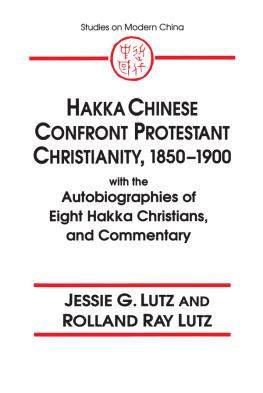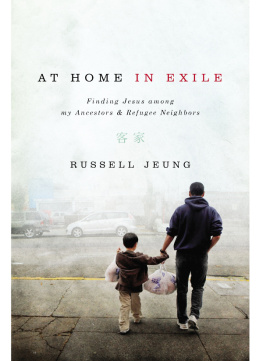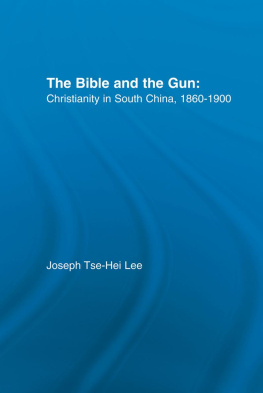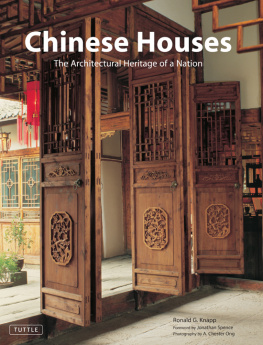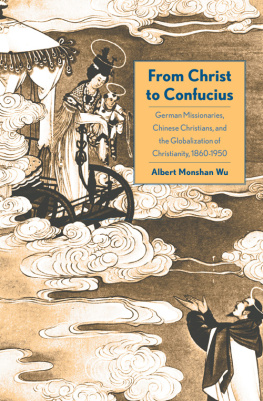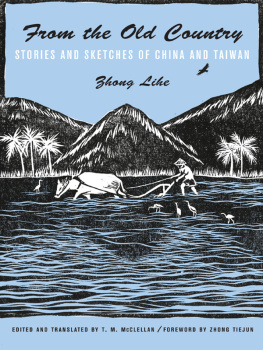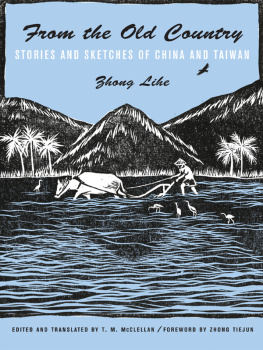HAKKA CHINESE
CONFRONT PROTESTANT CHRISTIANITY
18501900
Hakka multi-family house. (From Basel Mission Archives)
Studies on Modern China
HAKKA CHINESE CONFRONT PROTESTANT CHRISTIANITY, 18501900
With the Autobiographies of Eight Hakka Christians, and Commentary
Jessie G. Lutz and Rolland Ray Lutz
IMAGINING THE PEOPLE
Chinese intellectuals and the Concept of Citizenship, 18901920
Edited by Joshua A Fogel and Peter Zarrow
INDUSTRIAL REFORMERS IN REPUBLICAN CHINA
Robin Porter
THE KWANGSI WAY IN KUOMINTANG CHINA, 19311939
Eugene William Levich
SECRET SOCIETIES RECONSIDERED
Perspectives on the Social History of Early Modern South China and Southeast Asia
Edited by David Ownby and Mary Somers Heidhues
THE SAGA OF ANTHROPOLOGY IN CHINA
From Malinowski to Moscow to Mao
Gregory Eliyu Guldin
MODERN CHINESE WRITERS
Self-Portrayals
Edited by Helmut Martin and Jeffrey C. Kinkley
MODERNIZATION AND REVOLUTION IN CHINA
June Grasso, Jay Corrin, and Michael Kort
PERSPECTIVES ON MODERN CHINA
Four Anniversaries
Edited by Kenneth Lieberthal, Joyce Kallgren, Roderick MacFarquhar, and Frederic Wakeman, Jr.
READING THE MODERN CHINESE SHORT STORY
Edited by Theodore Huters
UNITED STATES ATTITUDES TOWARD CHINA
The Impact of American Missionaries
Edited by Patricia Neils

An East Gate Book
First published 1998 by M.E. Sharpe
Published 2015 by Routledge
2 Park Square, Milton Park, Abingdon, Oxon 0X14 4RN
711 Third Avenue, New York, NY 10017, USA
Routledge is an imprint of the Taylor & Francis Group, an informa business
Copyright 1998 Taylor & Francis. All rights reserved.
No part of this book may be reprinted or reproduced or utilised in any form or by any electronic, mechanical, or other means, now known or hereafter invented, including photocopying and recording, or in any information storage or retrieval system, without permission in writing from the publishers.
Notices
No responsibility is assumed by the publisher for any injury and/or damage to persons or property as a matter of products liability, negligence or otherwise, or from any use of operation of any methods, products, instructions or ideas contained in the material herein.
Practitioners and researchers must always rely on their own experience and knowledge in evaluating and using any information, methods, compounds, or experiments described herein. In using such information or methods they should be mindful of their own safety and the safely of others, including parties for whom they have a professional responsibility.
Product or corporate names may be trademarks or registered trademarks, and are used only for identification and explanation without intent to infringe.
Library of Congress Cataloging-in-Publication Data
Lutz, Jessie Gregory, 1925
Hakka Chinese confront Protestant Christianity, 18501900: With the autobiographies of eight Hakka christians, and commentary / by Jessie G. Lutz and Rolland Ray Lutz,
p. cm.
An East gate book.
Includes bibliographical references.
ISBN 0-7656-0037-4 (alk. paper). ISBN 0-7656-0038-2 (pbk. : alk. paper)
1. Hakka (Chinese people)Missions. 2. MissionsChinaKwangtung ProvinceHistory19th century. 3. Evangelische Missionsgesellschaft in BaselHistory. 4. Kwangtung Province (China)Church history19th century. I. Lutz, Rolland Ray, 1921 . II. Title.
BV3423.H25L88 1997
275.1081dc21 97-20828
CIP
ISBN 13: 9780765600387 (pbk)
ISBN 13: 9780765600370 (hbk)
For Knight Biggerstaff and Paul R. Sweet
Friends and Mentors
Contents
The year 1997 marks the one hundred fiftieth anniversary of the founding of the Hakka Church or Chong Zhen church. It therefore seems an appropriate time to commemorate the dedicated work of both the initiators of the Basel China mission: Karl Gtzlaff, Theodor Hamberg, and Rudolf Lechler, and the earliest Chinese evangelists: Jiang Jiaoren, Zhang Fuxing, Dai Wenguang, Xu Fuguang, Zhang Zhongmu, Lai Xinglian, Zhang Yunfa, and Li Zhenggao. The latter were crucial to the founding and growth of the first congregations as well as to the beginnings of the indigenization of the Hakka church.
We hope that the biographies of these eight Gehilfen with the commentary will also make a contribution to knowledge about the ethnic group known as the Hakka. We have benefited from excellent studies of the Hakka during the second half of the twentieth century by anthropologists, sociologists, and historians. Our work, which concentrates on Hakka of the nineteenth century, will, we trust, complement these studies.
In research for this book we have incurred debts to many people: our Hakka friends, especially Andrew Y. L. Cheung, and archivists: David Jenkins and Wiltraud Haas of Basel Evangelical Missionary Society, Barbara Faulenbach of the United Evangelical Mission in Wuppertal-Barmen, Martha Smalley of the Special Collections of the Yale University Divinity School, and J. M. Walpole of Selly Oak Colleges Library. Also, Nicole Constable, who provided us with introductions to members of the Christian community of Chongqian tang (Shung Him Tong). To all we express our deep gratitude for their assistance and hospitality.
Responsibility for errors in translation, transliteration, or interpretation is of course ours.
European romanization of Chinese was not standardized in the mid-nineteenth century. Great variation occurred, a name or place being transliterated differently even by the same author and within one document. Theodor Hamberg, who was Swedish, initially used ch for the zh sound, for example, while the Germans used tsch. Sometimes Changle was written as Tschonglok and sometimes as Tschhonglok even though in other instances the double h was meant to convey a different sound.
In the interest of intelligibility and simplicity, we have substituted pinyin in the text and even in quotations. In footnote references to Basel and Rhenish Mission Archives, however, the Germany transliteration used by the archive has been retained as an aid to scholars. Also, we have ordinarily used the transliteration employed by the Chinese authors themselves in the bibliography.
For the more important names and places, the glossary provides the German transliteration, the Chinese characters if known, and the Cantonese or Hakka equivalent where relevant. Since the Chinese characters are not available for many of the terms, there may be some errors in the transliterations; corrections would be welcomed. Where it has been impossible to deduce the pinyin with any certainty, the German transliteration has been employed.
| BMG | Basel Missionsgesellschaft |
| Br. | Brother |
| CMYB | China Mission Yearbook |
| CR | The Chinese Recorder |
| Com | Committee |
| Corres | Correspondence |
| Insp | Inspector |
| No | number |
| RMG | Rhenish Missionsgesellschaft |
| VEM | Vereinte Evangelische Mission |
Maps

